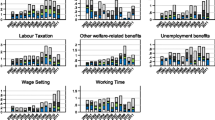Abstract
The debate about European monetary union has so far been dominated by questions of fiscal convergence, the adequate conversion exchange rate and the stability of the Euro. Relatively little attention has been given to the labour market effects although labour market performance will be crucial for the long-term success or failure of EMU. The following article deals with the interrelationship between EMU and labour market flexibility in Euroland.
Similar content being viewed by others
References
P. B. Kenen: Preferences, Domains, and Sustainability, in: American Economic Review, Papers and Proceedings, Vol. 87 (2), 1997, pp. 211–213, here p. 212.
R. A. Mundell: A Theory of Optimum Currency Areas, in: American Economic Review, Vol 51., 1961, pp. 657–665, here p. 657.
R. Dornbusch: The Effectiveness of Exchange-rate Changes, in: A. Botho (ed.): International Competitiveness, Oxford Review of Economic Policy, Vol. 12, No. 3, 1996, pp. 26–38, here p. 31.
More evidence on successful—as well as on less successful— currency devaluations is given in D. Dohse, C. Krieger-Boden: Währungsunion und Arbeitsmarkt. Auftakt zu unabdingbaren Reformen, Kieler Studie, No., 290, Tübingen 1998, p. 30 ff.
See for instance P. De Grauwe, W. Vanhaverbeke: Is Europe and Optimum Currency Area? Evidence from Regional Data, CEPR Discussion Paper, No. 555, 1991; T. Bayoumi, B. Eichengreen: Shocking Aspects of European Monetary Integration, in: F. Torres, F. Giavazzi (eds.): Adjustment and Growth in the European Monetary Union, Cambridge, Mass. 1993; J. Decressin, A. Fatás: Regional Labor Market Dynamics in Europe, in: European Economic Review, Vol. 39, No. 9, 1995, pp. 1627–1655; for an overview see D. Dohse, C. Krieger-Boden, op. cit., Währungsunion und Arbeitsmarkt. Auftakt zu unabdingbaren Reformen, Kieler Studie, No. 290, Tübingen 1998, p. 19 ff.
J. A. Frankel, A. K. Rose: The Endogeneity of the Optimum Currency Area Criteria, in: The Economic Journal, Vol. 108, 1998, pp. 1009–1025, here p. 1010.
P. Krugman: Lessons of Massachusetts for EMU, in: F. Torres, F. Giavazzi (eds.), op. cit. The Endogeneity of the Optimum Currency Area Criteria, in: The Economic Journal, Vol. 108, 1998, pp. 1009–1025, here p. 1010.
J. A. Frankel, A. K. Rose, op. cit. The Endogeneity of the Optimum Currency Area Criteria, in: The Economic Journal, Vol. 108, 1998, pp. 1009–1025, here p. 1010.
R. Layard, S. Nickell, R. Jackman: Unemployment: Macroeconomic Performance and Labour Market, Oxford 1991; T. Tyrväinen: Wage determination in the long run, real wage resistance and unemployment: multivariate analysis of cointegration relations in 10 OECD economies, Discussion Papers, No. 95, 12, Bank of Finland, Helsinki 1995.
F. Bickenbach, R. Soltwedel: Produktionssystem, Arbeitsorganisation und Anreizstrukturen: Der Paradigmenwechsel in der Unternehmensorganisation und seine Konsequenzen für die Arbeitsmarktverfassung, in: D. Cassel (ed.): 50 Jahre Soziale Marktwirtschaft. Ordnungstheoretische Grundlagen, Realisierungsprobleme und Zukunftsperspektiven einer wirtschaftspolitischen Konzeption, Schriften zu Ordnungsfragen der Wirtschaft 57, Stuttgart 1998, pp. 491–534.
L. Calmfors, J. Drifill: Bargaining structure, corporatism and macroeconomic performance, Economic Policy 6, 1988.
N. Berthold, R. Fehn: Evolution von Lohnverhandlungssystemen —Macht oder ökonomisches Gesetz?, in: W. Zohlnhöfer (ed.): Die Tarifautonomie auf dem Prüfstand, Schriften des Vereins für Socialpolitik, Vol. 244, 1996; D. Dohse: Charakteristika von Lohnverhandlungssystemen und makroökonomische Performance, Institut für Weltwirtschaft, Kiel 1999 (mimeo).
D. Dohse, C. Krieger-Boden, op. cit., Währungsunion und Arbeitsmarkt. Auftakt zu unabdingbaren Reformen, Kieler Studie, No. 290, Tübingen 1998, pp. 58 ff.
OECD: The OECD Jobs Study. Evidence and Explanations, Paris 1994, p. 64.
D. T. Coe, D. J. Snower: Policy Complementarities: The Case for Fundamental Labor Market Reform, IMF Staff Papers, Vol. 44 (1), 1997, pp. 1–35.
J. Addison, W. S. Siebert: The Course of European-level Labour Market Regulation, in: J. Addison, W. S. Siebert (eds.): Labour Markets in Europe: Issues of Harmonization and Regulation, Manchester 1997.
K.-H. Paqué: Does Europe's Common Market Need a ‘Social Dimension’? Some Academic Thoughts on a Popular Theme, in: J. T. Addison, W. S. Siebert (eds.), op. cit.; Labour Markets in Europe: Issues of Harmonization and Regulation, Manchester 1997. R. Soltwedel: Social Engineering in Europe: A German Perspective, in: J. T. Addison, W. S. Siebert (eds.), op. cit. Labour Markets in Europe: Issues of Harmonization and Regulation, Manchester 1997.
Kronberger Kreis: Sozialunion für Europa?, Schriftenreihe des Frankfurter Instituts, Vol. 31, 1996.
Sachverständigenrat zur Begutachtung der gesamtwirtschaftlichen Entwicklung: Reformen voranbringen, Jahresgutachten 1996/1997, Stuttgart 1996, par. 434; M. Mussa: Political and Institutional Commitment to a Common Currency, in: American Economic Review Papers and Proceedings, Vol. 87 (2), 1997, pp. 217–220.
R. I. McKinnon: EMU as a Device for Collective Fiscal Retrenchment, in: American Economic Review, Papers and Proceedings, Vol. 87 (2), 1997, pp. 227–229, here p. 228; D. Salvatore: The Common Unresolved Problem with the EMS and EMU, in: American Economic Review, Papers and Proceedings, Vol. 87 (2), 1997, pp. 224–226, here p. 225.
H. Siebert: The Euro: A Dozen Do's and Don't's, Kiel Discussion Paper, No. 312, Institut für Weltwirtschaft, Kiel 1998.
See OECD, op. cit. The OECD Jobs Study. Evidence and Explanations, Paris 1994, p. 64.
R. Soltwedel: Dynamik der Märkte—Solidität des Sozialen. Leitlinien für eine Reform der Institutionen, Kiel Discussion Paper, No. 297/298, Institut für Weltwirtschaft, Kiel 1997.
See e.g. P. Milgrom, J. Roberts: Continuous Adjustment and Fundamental Change in Business Strategy and Organization, in: H. Siebert (ed.): Trends in Business Organization: Do Participation and Cooperation Increase Competitiveness?, Kiel 1995, pp. 231–258; as well as F. Bickenbach, R. Soltwedel, op. cit., Dynamik der Märkte—Solidität des Sozialen. Leitlinien für eine Reform der Institutionen, Kiel Discussion Paper, No. 297/298, Institut für Weltwirtschaft, Kiel 1997. and the references given there.
Author information
Authors and Affiliations
Rights and permissions
About this article
Cite this article
Dohse, D., Krieger-Boden, C. & Soltwedel, R. EMU calls for comprehensive labour market reform. Intereconomics 34, 55–63 (1999). https://doi.org/10.1007/BF02927836
Issue Date:
DOI: https://doi.org/10.1007/BF02927836




